A brief account of Bell Founding in Bridgwater, by Tony Woolrich
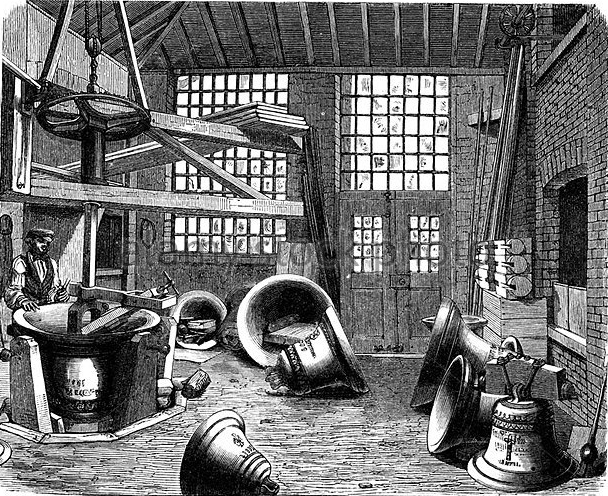
Medieval bells
An account dated 1319 for founding a new bell for the parish church survives in the Borough Archives in the Heritage Centre at Taunton. £14 3s 3 1/2 d was raised, and £13 13s 6d was spent on new metal, for scrap was also used. In total,1,781 lb of metal was used. It is not known if bell-founding continued in later centuries.
Modern Bells
The first recorded founder of modern times was Thomas Bayley, nephew of Thomas Wroth II of Wellington, bell-founder. He set up a foundry on the corner of St Mary Street and Dampiet Street in 1739. From 1749 he was in partnership with Robert Street, (d 1755) trading as Bayley and Street. The business was acquired by Thomas Pyke (1742/3-1829) after Bayley’s death, in 1775, and from 1782 Pyke employed George Davis as bell founder. After Davis’s death, Isaac Kingston became the founder. On Isaac’s death in 1808 he was succeeded by his son John Kingston. On his death in 1831 he was succeeded by his son Edwin, who died in 1832.
Bridgwater was the last working bell foundry in Somerset. During the 93 years it was active, it supplied some 211 parishes in the South West and South Wales, and it made 258 bells for Somerset churches alone. At least one Bayley bell is in America in Cumberland County, New Jersey.
Bridgwater was the last working bell foundry in Somerset. During the 93 years it was active, it supplied some 211 parishes in the South West and South Wales, and it made 258 bells for Somerset churches alone. At least one Bayley bell is in America in Cumberland County, New Jersey.
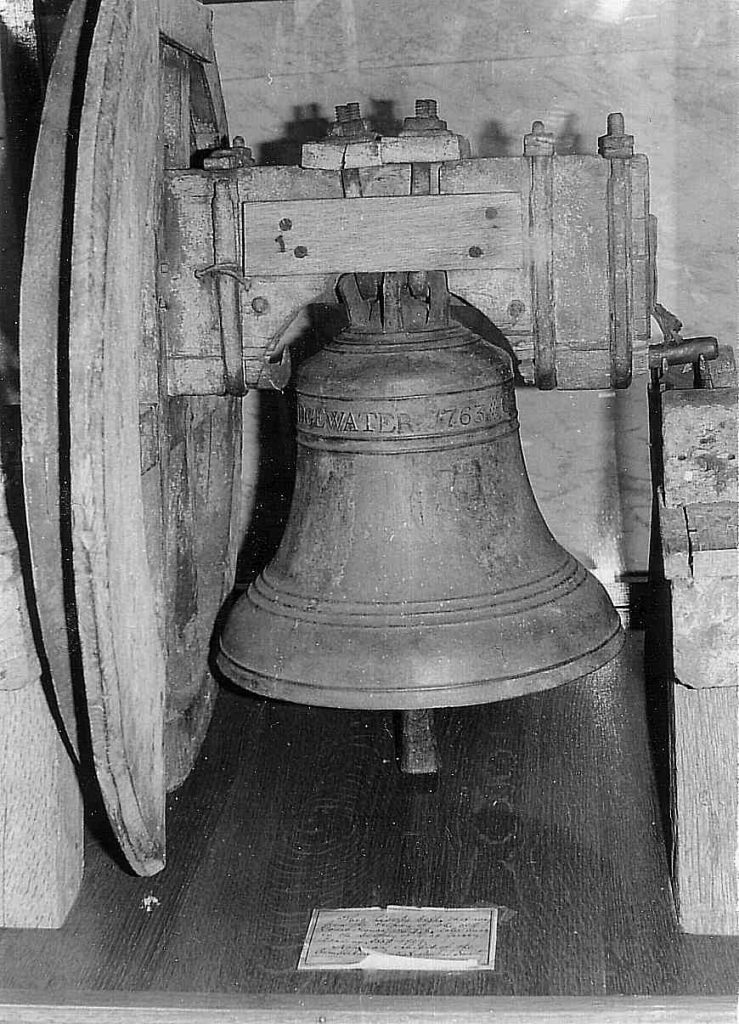
It is tuned to F
Photograph courtesy Bill Chestnut
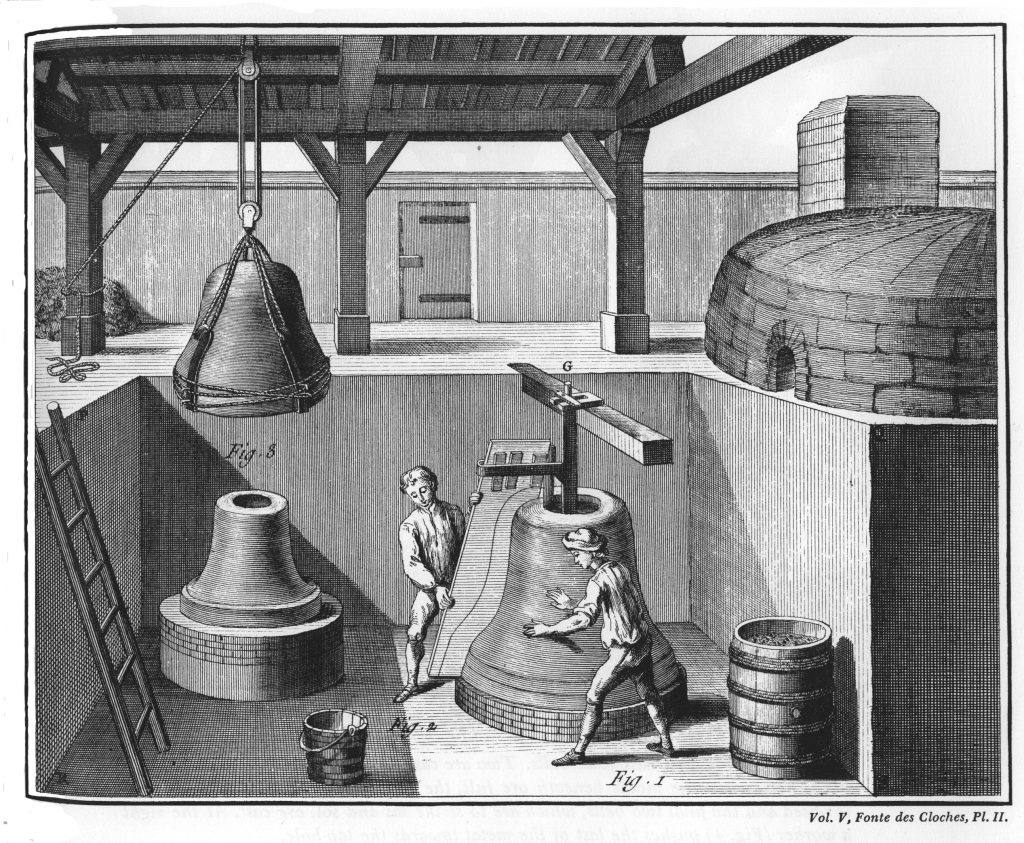
The Manufactory
Throughout its lifetime the foundry made and sold a wide-range of goods. Very little is now known of its business history, but much can be gleaned from the elaborate engraved trade cards they issued, advertising their wares, such as this of c 1770. The originals have elaborate pictorial engravings showing their wares.
Street & Pyke
Braziers, Founders, Tinmen, Ironmongers
at their Warehouse in Bridgwater:
sell on the best terms
besides every article of these several Trades.
All sorts of Cutlery and Pewter Goods,
Church Clocks, Chimes and Branches,
House Clocks, Watches and other Time pieces.
Deals
Cabinet & Clockmakers Brass work
Salvers Mortars and Cocks of any size.
Bar Iron and steel
Glass, Lead, Oils & Colours with
a large Variety of other Particulars.
Peals of Bells
Cast & Hung after the most
Improved Manner.
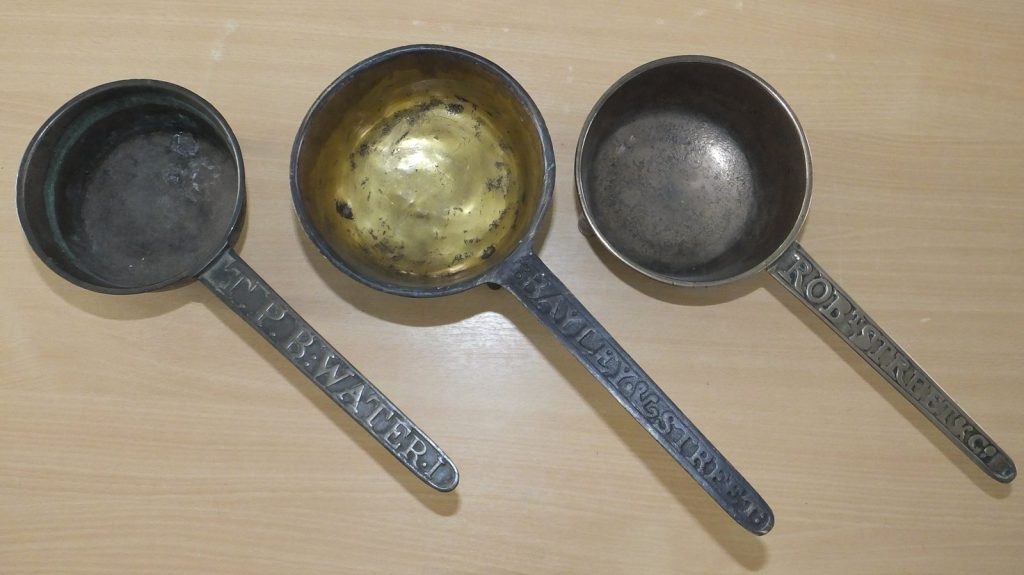
Blake Museum Collection
Photograph by Mike Searle
These were cast with three short legs, so they could rest in the hot embers without falling over. They had a speciality of making painted clock plates for other clock-makers, and also cast-iron false back-plates, distributing them throughout the South West of England in competition with the Birmingham dial makers.
They advertised in 1773 that they employed 200 men. The firm also made sets of scales and weights for testing counterfeit gold coins. They advertised in 1775 that were preparing 10,000 sets. This is more fully described in the Blake Museum’s leaflet on Weights and Measures.
They made elegant brass chandeliers, examples of which are in a number of churches still. Cannon, including small swivel guns for saluting at sea, were also made by the firm, and they also advertised in 1776 making spinning jennies, undoubtedly for the West Country cloth trade. Part of what they sold, such as cutlery and pewter goods would have been obtained from other manufacturers in the Midlands, and brought to Bridgwater first by canal and then down the Severn by trow. These included goods such as tea trays, tea and coffee urns, fire-irons, candle sticks, fire-grates, etc. Japanned iron-ware could have been obtained from Ponytpool at this time as well.

Blake Museum Collection
Photograph by Mike Searle
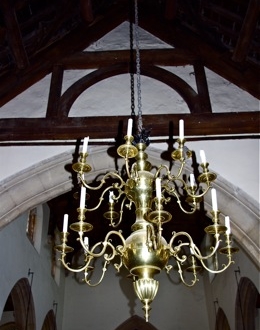
Photograph by the late Dr Peter Cattermole
Thomas Pyke
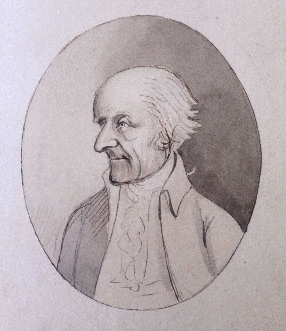
Blake Museum collection
Thomas Pyke was born in 1743 or 4, probably the vicinity of Combe St Nicholas, near Chard and became a partner of Robert Street at the foundry from 1768. He negotiated with the Coalbrookdale Company over the construction of the iron bridge over the Parrett, opened in 1798. He was Mayor of Bridgwater and magistrate, twice. He served on the Commission of Sewers for the Levels. In 1791 he was one of the founders of the Bridgwater and Somerset Bank.
He married Ann Wollcott of North Petherton in 1777. They had seven children of whom two reached adulthood. He was a non-conformist and worshipped at the Presbyterian (now Unitarian) chapel in Dampiet street, opposite the foundry.
Around the turn of he C18/19 he became involved with a family named Wakely, about whom little is known but who played an important part in running the foundry. The Taunton Courier and Western Advertiser recorded that in Juner1814, the men of Mr Wakely’s foundry paraded through the town to celebrate the First Peace of. Paris, 30 May. The firm became bankrupt in 1816 and this advertisement shows the extent of the wares they supplied.
Taunton Courier, and Western Advertiser – Thursday 03 October 1816 p 4:
BRIDGWATER.
Remarkably cheap bargains.
In
IRONMONGERY, BRAZIERY, AND JAPANNED GOODS.
NOW SELLING,
(At the Shop lately occupied Mr. Nicholls , in Fore -street,) under a Statute Bankruptcy, by order the Affignees of a HENRY, MICHAEL, and WILLIAM , WAKELY, ALL the Remaining Stock of IRONMONGERY, BRAZIERY, and JAPANNED GOODS, removed for the conveniency of tale, besides variety other Articles ; The Goods are as follow :-
A large quantity of common Tea Trays, at remarkably low prices; new and second hand Tea and Coffee Urns; a large assortment of Paper Trays and Bottle Stands, with Gold Borders; Paper Snuffer Pans and Waiters ; Ladies’ and Gentleman’s Japan Dressing Cases; Japan Plate Warmers ; Iron And Wire Fenders ; Tin Ditto, varnished ; Iron Coal Scoops, and Copper Ditto Copper globe Tea Kettles, warranted not to leak ; Ditto oval ditto, and Copper Warming Pans ; Copper Furnaces ; Securing Varnish, and Black do.; Charcoal, Oils, and Colours; a large assortment of Iron Wire; Japan Tea Waiters, and Canisters; elegant Stove Grates, with Brass Mountings; Common Ditto; Iron Cinder Shovels; Rush and Rope Mats; large quantity of ornamented Clock Dials ; Brass and Copper Scales and Weights of all sizes; Ditto and Prince’s Metal Candlesticks; Locks, Hinges, and Bolts; House Bells, with modern Cranks ; Pewter Measures, and a variety of other Wares ; Lancafbtre Files; Carpenters’ Tools, ef every description; Metal and Iron Spoons; Braziers’ and Tin-men’s Stakes, Hammers; Guns and Gun Furniture, &c, &c.
Like the Wakelys, Thomas Pyke was made made bankrupt in 1815, and the property was disposed of;
Taunton Courier, and Western Advertiser – Thursday 16 December 1819:
Lot 1 – A very capital FREEHOLD PROPERTY comprising a good dwelling house, with vestibule ; two parlours, and other convenient rooms, on the ground floor ; four good bed rooms an underground kitchen, cellar, pantry , and store rooms; together with an excellent retail shop, warehouses, BELL and BRASS FOUNDRY rooms, workshops for various branches, stoves oven spaces. &c. &c, in which the Brass and Bell Foundry and japan and hardware manufactory was for many years carried by Messrs. Pyke, and Messrs. Wakleys, the whole occupying about nine thousand square feet of ground, eligibly situated and calculated for carrying on business on very extensive scale.
Lot 2,- A most desirable range of FREEHOLD BUILDINGS, separated from lot I by cottage,) comprising Messs. Pyke’s old banking house with various rooms the ground floor, five bed rooms, closetsand garret over the same, the old retail shop, counting house, were room &c together with the dwelling house in which Mr.Pyke now resides, confining two parlours, kitchen, and other rooms on the ground floor, and five or six bed rooms over the fame, open yard &c. &c. the whole occupying about 5000 square feet of ground. These buildings are partly fronting St. Mary Street, and partly Dampiet Ward and in an excellent situation for carrying on any mercantile concern.
Lot 3 – A FREEHOLD DWELLING HOUSE, in the occupation of Philip Hooper, comprising kitchen &c and two rooms over, with another unoccupied building adjoining the fame, both of which are fronting Dampiet Ward, together with the passages, two very large workshops behind, and garden adjoining, the whole standing upon nearly 5000 square feet of land, and ia a desirable spot for a private residence.
Lot 4.- A FREEHOLD DWELLING HOUSE, fronting Dampiet Ward, in the occupation of William Podger, comprising akitchen &c. and two rooms over.
Lot 5 – A FREEHOLD DWELLING HOUSE, fronting Dampiet Ward, in the occupation of James Batten, comprising kitchen, shop, and pantry on the ground floor, with two rooms over.
Lot 6.- A FREEHOLD DWELLING HOUSE, in the Back Court, in the occupation of James Quick, comprising a kitchen, pantry, and two rooms over.
Lot 7 – FREEHOLD DWELLING HOUSE, in the Back Court, in the occupation James Baker, comprising kitchen, dye house, &c. and two rooms over.
Lot 8. -A FREEHOLD DWELLING HOUSE, the Back Court, the occupation of James Mountsher, comprising a kitchen &c. and two rooms over.
The property was eventually sold in 1823. Lot 1 had been purchased before the auction by William Baker FGS, a Bridgwater currier and eminent natural historian, who used part as his private museum. The remainder was bought in the bankruptcy sale by John Bowen, who had been an apprentice there c1795-1800. Pyke died December 1829.
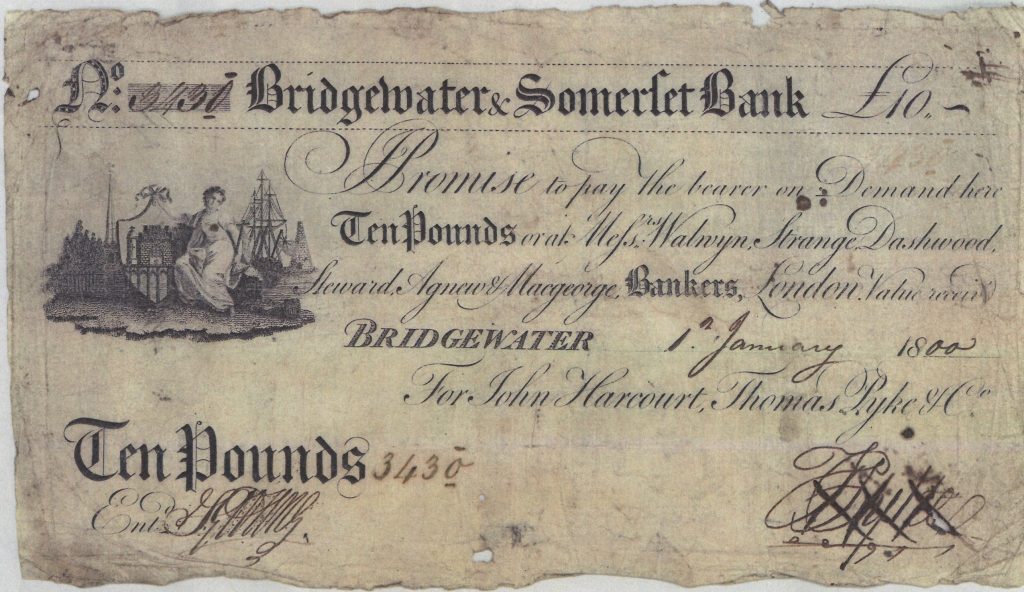
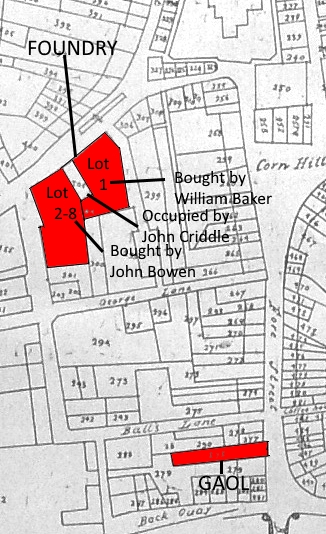
Bridgwater Gaol
There was a prison in Bridgwater in medieval times, and in 1729 the quarter sessions established a Bridewell for the borough and parish, probably an extension to the town’s prison, and set up a whipping post there. Its condition was severely criticized by John Howard, the prison reformer, who visited it on 10 Sept 1774, when there were no prisoners. He wrote:
BRIDGEWATER TOWN GAOL.
Only one middle sized room: and one of the two windows stopped up. In this room at Midsummer Quarter Sessions 1774 were shut up twenty seven Prisoners. At Summer Assize the same year, thirteen; two of them, Women. Assize generally lasts from Monday to Saturday. The Keeper’s mother complained to me of the confusion and distress occasioned by confining Prisoners thus for so long a time. She said there were but few, at any time, who could pay for beds, and separate rooms.
This building was located on part of the site behind the Cornhill market house, moving to the south side of Fore Street near the river, presumably after the Market House was begun in 1778. George Parker wrote a poem for a fund-raising exhibition in the Town Hall to help pay for the Restoration of St Mary’s Church. It took place in November 1854. In the Notes is the following passage:
A handsome cross once stood on the Corn Hill. Between it and the Bridge stands the old Jail, over which is a clock; some years since the hours were struck by two large antiquated wood figures on two excellent bells. They held in their hands a sort of battle axe, and their arms were moved by means of springs. When the old Town Hall which stood there was removed, and the building became altered, these figures were taken down and sold by order of the authorities, which is to be regretted. I have heard, at some Election freak, a platform was made at night upon the Cornhill, and those two figures craftly removed there; where, in the morning, they appeared dressed as representing two of the Candidates.
Note that the Town Hall referred to here may be referring to the site of the Gaol in Fore Street, rather than the modern Town Hall in the High Street.
The frontage of the Fore Street prison was rebuilt by Richard Carver in 1834. This in turn was sold for development in 1876 and was replaced by a shop.
Bridgwater Mercury – Wednesday 21 June 1876, p 1:
LOT I- A TENEMENT situate in Fore street, Bridgwater (heretofore known as the Borough Gaol), now unoccupied. This property is bounded east with property belonging to Messrs. Edwards and Lott, north with Fore-street, and west with property belonging to Mr. George Bond and Mr. Richard Oliver Backwell, and measures in front 23 feet 7 inches, at the back 26 feet, and in depth from north to south 161 feet.
The largest bell is dated 1823, weighs 215 pounds and sounds G. It is marked J. Kingston, Founder, Bridgwater and B. Cockings Clockmaker
The medium sized bell is dated 1706 and initialled AR. It weighs 117 pounds and sounds Middle C. The founder was probably Abraham Rudhall of Gloucester
The smallest bell is undated and unsigned. It weighs 45 pounds and sounds Treble E
It is probable that the bells were removed to the museum then in the Town Hall at the time of the demolition. At the same time a pane of glass, on which a prisoner had scratched a message was also saved. This in on display in a case adjacent to the bells, together with fetters and leg irons of the time.
More on the gaol can be read here.
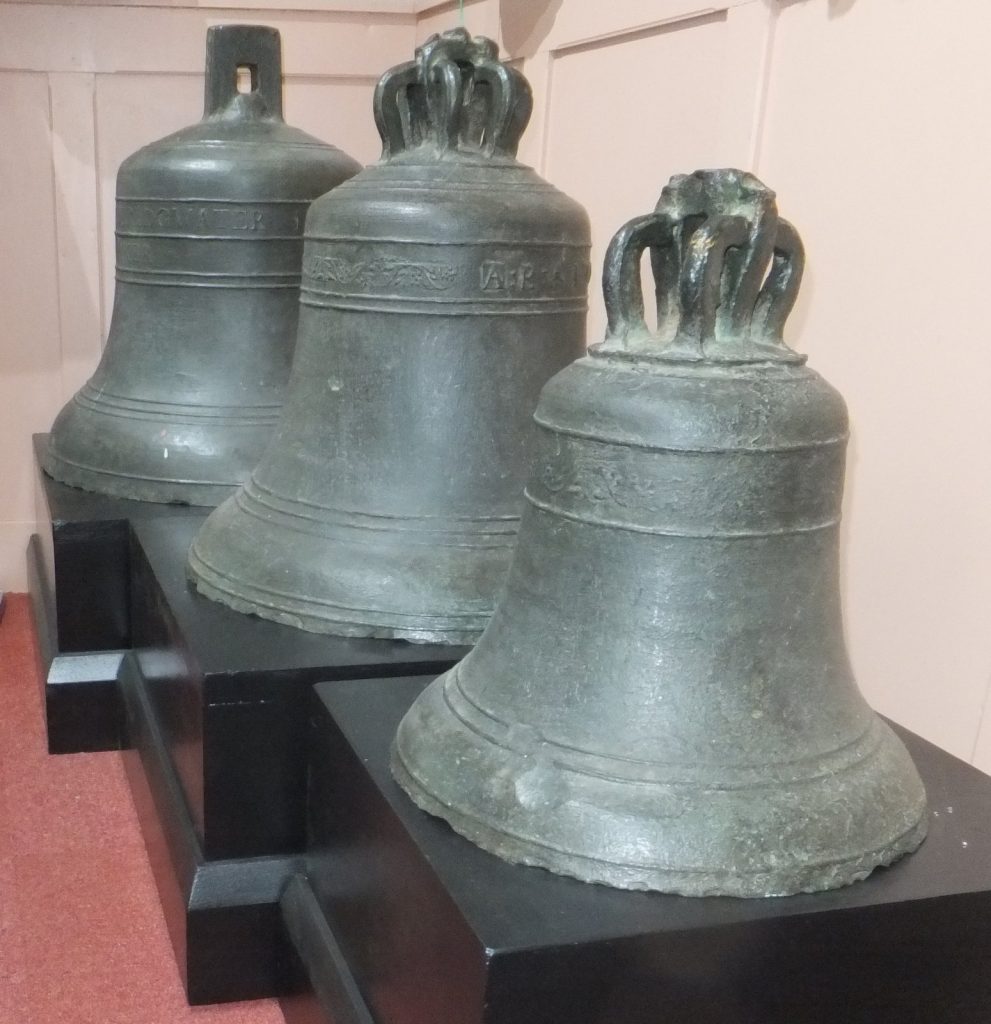
Photograph by Mike Searle
Sources
Christopher Dalton, The Bells and Belfries of Dorset, pt III, 2005,pp 928-932
T. Bruce Dilks, ed, Bridgwater Borough Archives, Vol 1, 1933 pp 64-67
George Massey & David Bromwich, The Church Bells of Somerset, 2011, pp 38-41
John G. M. Scott, with Frank D. Mack and James M. Clark, Towers & Bells of Devon, 2007, pp 117-117
Niall & Deborah Woodford, The Thristle clockmakers of Somerset, 1765-1899, 2016: Chapter 20, on Thomas Pyke
A. P. Woolrich, http://www.bridgwaterscientists.org.uk for William Baker and John Bowen.
Acknowledgements
Very many thanks to:
Ros Boone for help on John Bowen
David Bromwich for help in Somerset, Devon & Dorset Bells
Mike Searle for Blake Museum photography
Deborah and Nial Woodford, for help on Thomas Pyke
Tony Woolrich 10/10/2019
